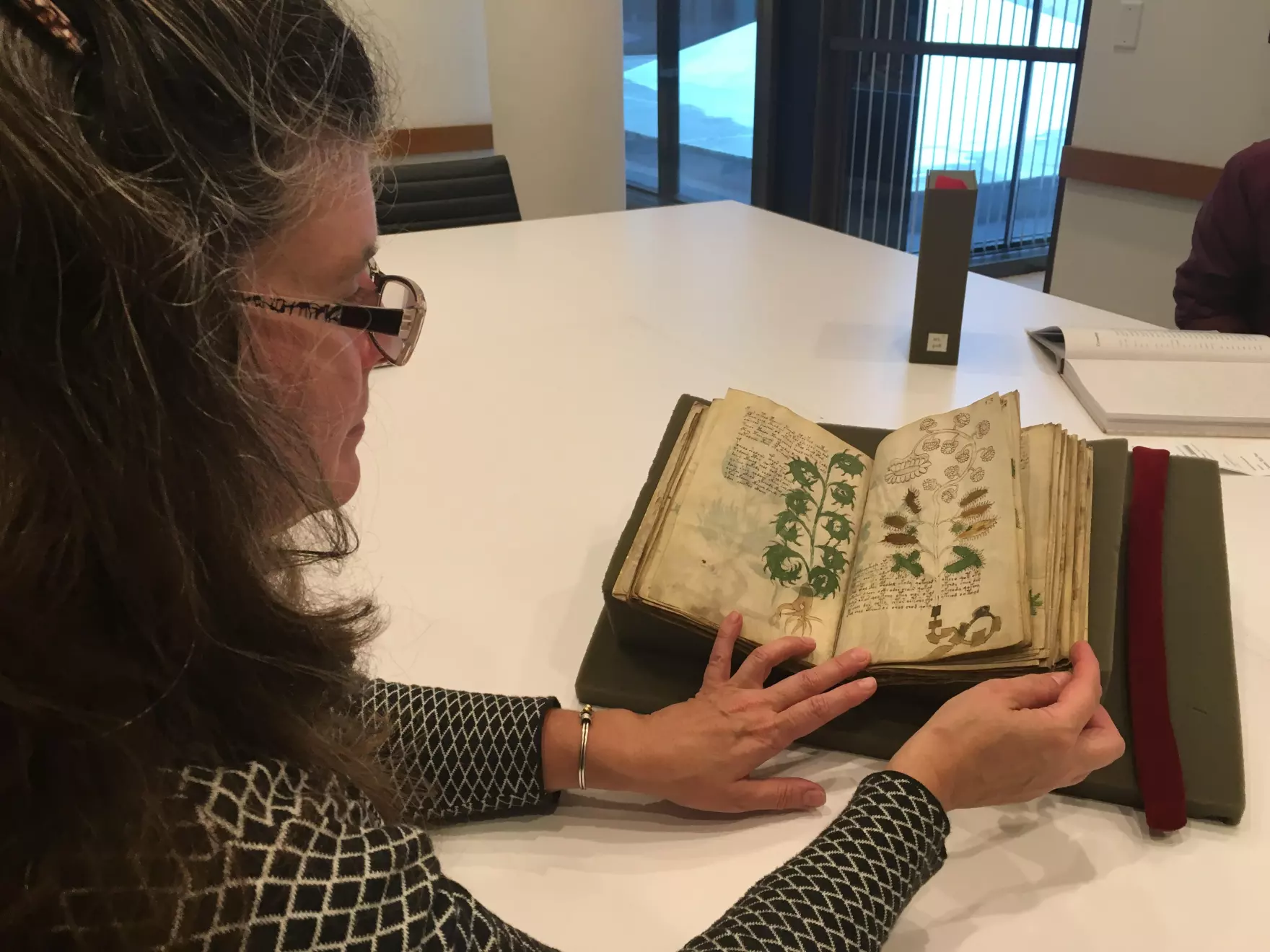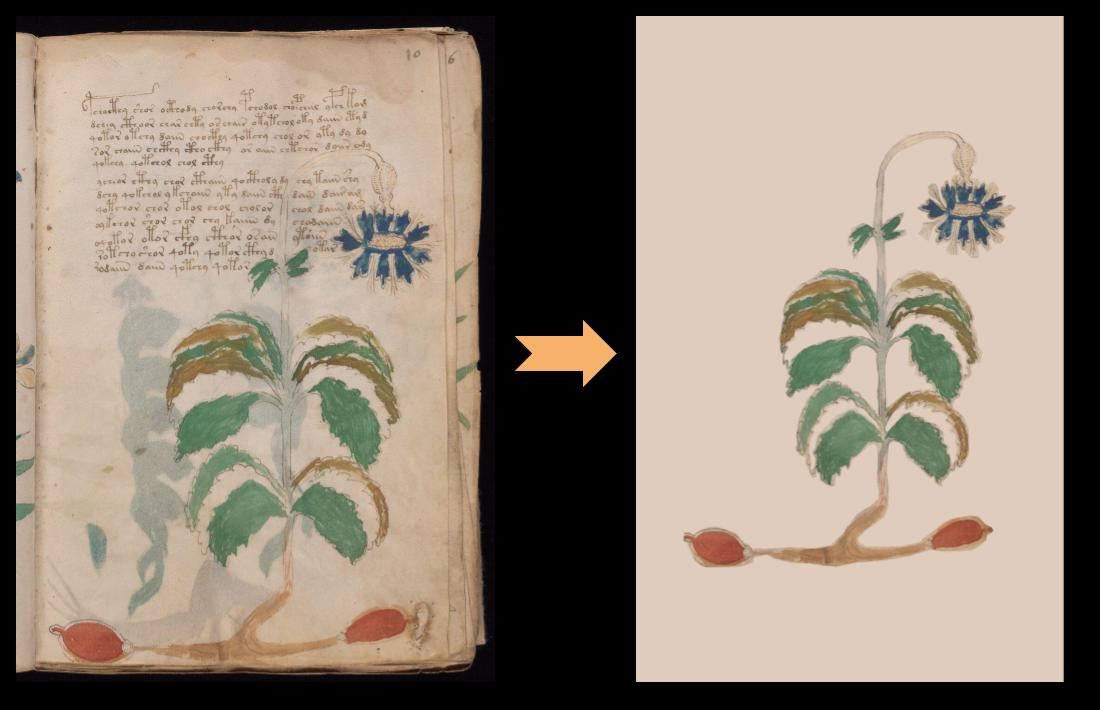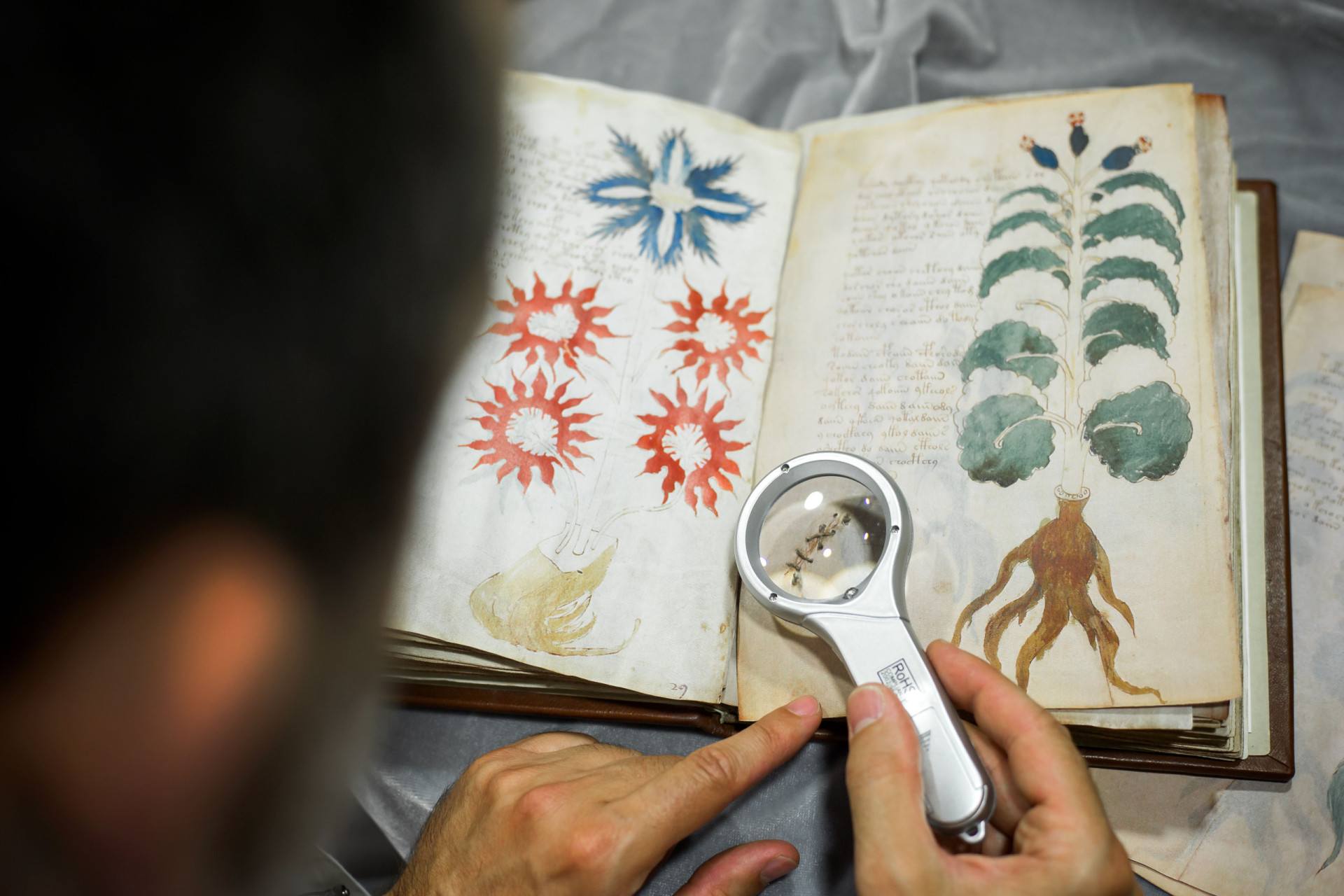With The Voynich GardenTM online application, you can contribute to the ongoing effort to unlock the secrets of the mysterious Voynich Manuscript. We hope that you participate by offering your proposed plant identifications, as well as your opinions on the various proposals of others.
Please don't hesitate to provide your feedback and suggestions regarding the application and this crowdsourcing research effort. You can email us at curator@cryptobotany.org
Welcome to the intriguing world of Cryptobotany!- The Voynich Manuscript
- The Voynich GardenTM
- Digital Images
- Plant Reference System
- Proposal ID and Plant Consensus Scores
- Historical Plant Identification Proposals
- What is Cryptobotany?
- Additional Resources
The Voynich Manuscript
The Voynich Manuscript is a fascinating and mysterious document that has puzzled scholars, cryptographers, and historians for centuries. Elegantly handwritten on vellum folios, it contains over 200 pages of script written around and over illustrations of plants, astronomical diagrams, and other mysterious symbols. Despite numerous attempts over the years by skilled cryptographers and linguists, the script has never been deciphered.

The vellum has been carbon dated to have originated sometime in the early 15th century, but that is one of the few facts that is known with much certainty. No one knows what language it is written in, who wrote it, or why. Nor what it actually says. As a result, the manuscript has been the subject of much speculation and debate. Some people believe that it contains a secret code or hidden message. Others think that it is simply a hoax or a meaningless work of art.
One of the most striking features of the Voynich Manuscript is its botanical illustrations. The manuscript contains dozens of detailed drawings of plants that seem to be unlike any known species. These illustrations are what inspired the idea for this present experiment in Cryptobotany Crowdsourcing. The hope is that by presenting these illustrations to a wide audience, we can tap into the collective knowledge of people around the world and potentially identify some of the mysterious plants depicted in the manuscript.

It is worth noting that the Voynich Manuscript is not without controversy. Some scholars have questioned its authenticity, suggesting that it may be a forgery or a hoax. Others have pointed out that the manuscript's illustrations of plants may not be accurate representations of real plants, and that they may have been created purely for artistic purposes. Perhaps that is true. But its shear length and the apparent effort that went into it suggest otherwise. (After all, why go through the immense effort to compose over 200 pages for a hoax or fraud when 100 pages would surely gain one just as much fame or wealth?) The prevailing opinion of most researchers is that the manuscript was created for some more practical and legitimate purpose.
Perhaps you may be the one to recognize in one of these illustrations a plant that you have seen before. Identifying one or more of the plants could be the initial crack that opens the door to discovering the origin and purpose of this intriguing document.
But what if those suggestions are true and these illustrations are not actually real plants at all, you ask? What if they are just the wild hallucinations of some poor devil who had lost his grip on reality? Well, even if that turns out to be the case, it is possible that the illustrations have some basis in real plants that the artist had seen, and that he combined some real features with imagined ones. Identifying plants that are similar to the illustrations, or that share particular features with them, may still be valuable for solving the mysteries of the manuscript. For example, if a pattern of common habitats or ranges (i.e. geographic areas where a plant grows) emerges, it could provide clues as to the origin of the manuscript or its author. Or identifying what features the artist tends to alter or stay faithful to can provide insights into the purposes of the manuscript as a whole.
Successful cryptanalysis rarely amounts to discovering a single 'key' that reveals the whole answer all at once. It often involves solving a series of component problems until the accumulated evidence points with confidence to a particular solution. The set of botanical illustrations is one of several curious aspects of the Voynich Manuscript; there are also the astrological and balneological illustrations, the manuscript's provenance, and, of course, its unique script. But the botanical illustrations have received little attention compared to those other features, especially when one considers the large number of illustrations contained in the manuscript, and the potential for them to be recognized by anyone regardless of their background or expertise.
The Voynich GardenTM
The Voynich GardenTM online application presents the remarkable plants depicted throughout the Voynich Manuscript for easy browsing and identification. Digital images of all 134 whole plant illustrations found in the manuscript are depicted in the rolling gallery. Any one of these can be selected to view an enlarged image for inspection. We welcome and encourage you to propose identifications of these plants, and to add your vote and comments on any of the plant identification proposals displayed in the accompanying table.
Digital Images
These digital images have been derived from high resolution images of the manuscript that have been made publically available by the Beinecke Rare Book and Manuscript Library at Yale University. Each whole plant illustration has been carefully clipped, cropped, and remounted. We believe the clean image of just the plant -- without the distractions of the accompanying script, blemishes, and shadow images (caused by ink transferred from adjacent folios) -- provides a clearer impression of the artist's orginal work and makes it more likely that someone might recognize and identify the plant.

In addition, we have created AI-generated renditions of each plant — reimagined as the artist might have seen them, had they truly existed as drawn. The inclusion of these images in the application was inspired by an amusing post by “quimqu” on the online forum voynich.ninja. While these photo-realistic depictions are undeniably pleasing to the eye, they should be regarded only as what they are — imaginative interpretations produced by an AI model.
One can switch between the viewing of these three different versions of the plant folio pages using the three buttons located across the top of each image.
Plant Reference System
The plants are referenced by the folio page of the manuscript on which they are located. Each of the 116 folios of the manuscript has a frontside page, termed "recto" (i.e. front and right-hand), and a backside page, termed the "verso" (i.e. back and left-hand). The conventional reference system for the folio pages indicates both the folio's ordinal number and its side (e.g. f8v or f27r). While almost all illustrations of the whole plants are found alone on their own page, there are a few pages that contain more than one whole plant. So we have appended an additional lowercase letter to the folio page reference to differentiate each plant (e.g. f27r-a vs f27r-b).
Proposal ID and Plant Consensus Scores
To gauge the level of agreement around the identification of each plant, we have included a
Proposal ID Score for each
proposed identification, and a Consensus Score on each plant. Each of these scores ranges from 0 to 100%.
The more people agree (and the fewer disagree) with a plant identification
The Proposal ID Score is defined as the ratio of the number of positive opinions on a proposal to the total number of opinions regarding the plant. For this purpose each vote to agree is considered a positive opinion on the proposal and the proposal itself implies a positive opinion of the proposer. Each vote to disagree is considered a negative opinion, and each conflicting proposal implies an additional negative opinion by the other proposer.
The Plant Consensus Score is defined as the difference between the maximum Proposal ID Score and the average of the remaining Proposal ID Scores.
Historical Plant Identification Proposals
Throughout the past century, various individuals, including Ethel Voynich, the widow of Wilfred Voynich, have presented numerous plant identification proposals. These have been documented in research papers, personal notebooks, and online platforms. We've endeavored to compile these historical suggestions and have integrated them into The Voynich GardenTM database. Within the application, these proposals can be recognized by the stacked-books icon (For the purpose of dating each proposal, we've adopted a streamlined method. We assign a single representative date to each proposer and then attribute all their plant suggestions to that specific date. While this method is straightforward, it may not always be precise. For instance, Ethel Voynich made several plant identifications over many years, which she documented in her private botanical notebooks. These notebooks were only made public after her passing in 1960. However, for simplicity, we've marked all her proposals with the 1960 date.
On several occasions, multiple historical researchers have identified the same plant for a specific illustration, albeit sometimes under different names or spellings. In such instances, we've showcased the proposal once, linking it to the researcher with the earliest date. Subsequent proposals are then mentioned in the comments, and additional agreements are tallied as votes.
We welcome any corrections or additions to these historical proposals. Kindly forward them to curator@cryptobotany.org.
What is Cryptobotany?

The word "cryptobotany" is a compound term derived from two Greek roots: "kryptós" (κρυπτός) and "botanē" (βοτάνη).
- "kryptós" (κρυπτός) means "hidden" or "secret."
- "botanē" (βοτάνη) refers to "plants" or "vegetation."
Additional Resources
- Rene Zandbergen provides an excellent dscription of the physical manuscript and the folio reference naming system, check out the Voynich.nu website.
- Stephen Bax has a post discussing the factors distorting plant images in the Voynich Manuscript. It can be found at https://stephenbax.net/?p=741
- One of the most active online forums dedicated to discussing the Voynich Manuscript can be found at: https://www.voynich.ninja/
- And one of the longest running mailing list for those interested in attempting to read the enigmatic manuscript is the Voynich Manuscript Mailing List at https://www.voynich.net/
